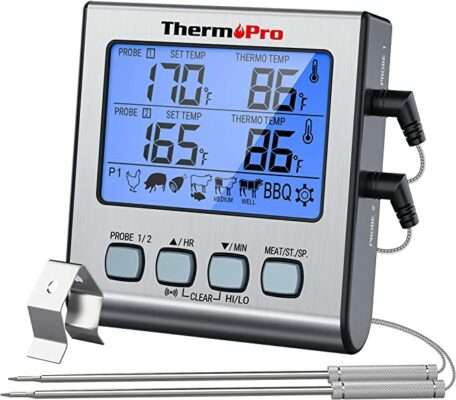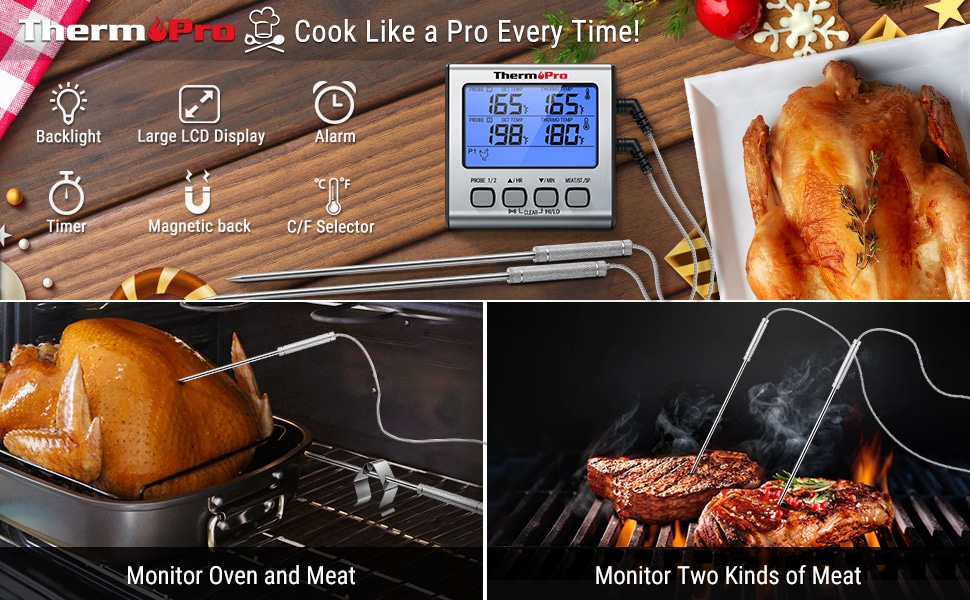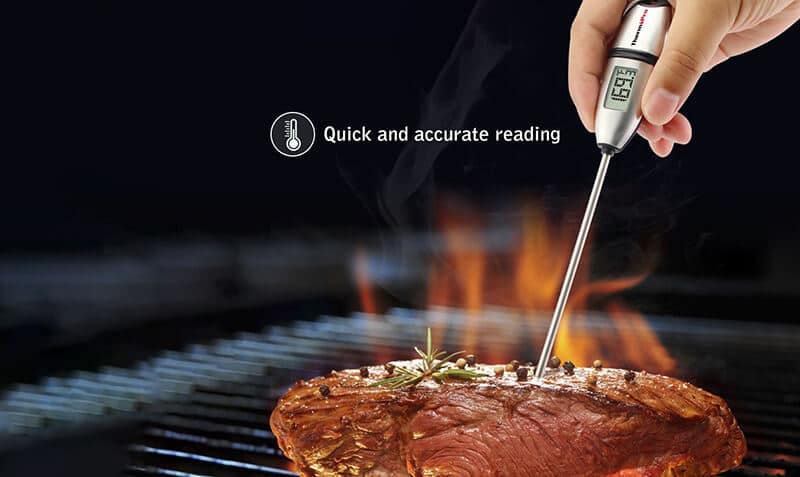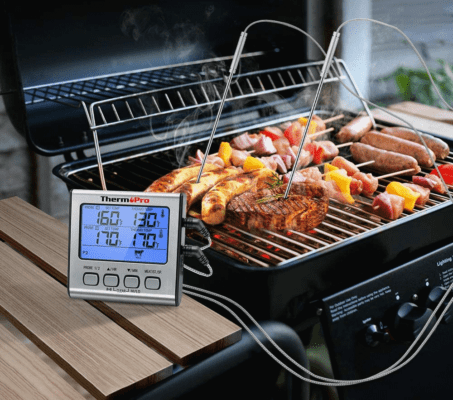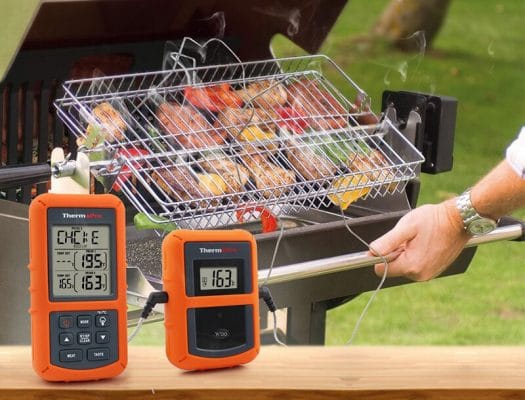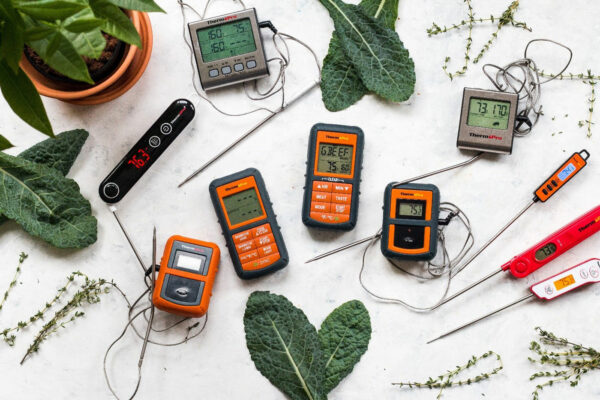The customer service team is always listening, taking notes, and quantifying complaints to ensure our products are continually improved. Due to selling directly to you, the customer, via Amazon, we can use product reviews to help us improve our existing products or help further development of new products.
Table of Contents
Knowing how to use a probe thermometer safely is especially critical when grilling and smoking meats, vegetables and cheese because the food thermometer can easily come into contact with direct heat.
Choosing the right food thermometer with probe and using it safely can prevent burnouts, inaccurate temperature readings and other probe thermometer safety risks when you try to adjust a thermometer that’s not positioned or working correctly.
How Can a Probe Burn Out While Grilling?
Digital probe for thermometer can burn out on grills and smokers when they come into contact with any source of heat that is higher than the thermometer’s maximum temperature limit. Steam can also penetrate the seam of transitions and cause a thermometer to malfunction by burning out the sensor.
Smokers and grills have one thing in common: They generate intense heat. Most people use the heat in grilling to cook fast, seal in juices and make diamond-shaped grill marks. Smokers diffuse heat and channel excess heat and smoke away.
Putting your probe where it receives direct heat from the fire or conductive materials can cause it to burn out or malfunction. One solution is to get a wireless meat thermometer.
Best Practices for Grilling
Using your thermometer is important on the grill because meat can easily be overcooked or undercooked, and you can’t always tell meat doneness by sight on a smoky grill. A leave-in probe can work well if you use the right techniques and keep cables and transitions away from hot spots and metal surfaces of the grill.
How to Use Leave-in Probes Properly While Grilling
Leave-in probes can work with both digital and wireless meat thermometers, but you must place the transmitter away from the high heat area of the grill. You can keep track of the internal food temperature with the ThermoPro TP17 wireless meat thermometer with dual probes as long as you carry the receiver with you. Wireless technology lets you mingle with friends and guests instead of being chained to the grill.
Checking the temperature of a wireless thermometer might defeat the purpose if you’re the type of person who hovers over the grill. It’s not a good idea to keep your receiver close to the grill’s high heat. Leave-ins allow you to monitor temperature changes, and advanced thermometers can alert you when they reach a certain temperature.
The most important thing to do when using a leave-in thermometer on the grill is to protect the cable and transition by feeding the cable through the designated holes and grommets in your grill that are made for that exact purpose. This prevents the need for closing the grill on cables. Leave-ins can be safe for use on grills if you follow these precautions:
- Choose a popular leave-in thermometer like ThermoPro TP17.
- Watch for flare-ups because they can burn out any cable or probe.
- Position the probe for thermometer in the middle of the thickest part of the meat.
- You might need to reposition the probe when you turn the meat.
- Avoid draping the cable over the grill grate and other hot spots.
- Wrap the cable and transition in aluminum foil to reflect excess heat and protect the thermometer from flare-ups.
Instant read meat thermometers are a good choice for use on the grill. You can monitor meat temperatures from multiple meats quickly, and you’re always ready to take a temperature reading. However, you should sanitize the thermometer after each use to prevent cross-contamination.
How Can a Probe Burn Out in a Low-and-slow Smoker?
Any form of cooking that uses fire or electricity can generate safety issues or result in undercooking or overcooking. That’s why accomplished chefs always use thermometers to gauge prices shades doneness to satisfy many tastes.
Many smoking lovers wonder how a low-and-slow smoker that cooks at 275-degrees Fahrenheit can burn out a temperature probe that’s rated safe up to 640 degrees.
The answer is that fire is hotter than 640 degrees, and its use in a smoker is diffused to build an average temperature of 275 degrees. There’s lots of excess smoke and heat that can damage your probe.
Where There’s Smoke, There’s Fire
There are hot spots that can cause your probe to burn out the sensor or cable insulation. Most barbecue smokers use some kind of diffuser to prevent the fire from burning or chacoalizing your food, but the diffusers don’t cover some areas where you might place your probe.
Your meat receives gentle heat and smoke, but your probe and cables might receive intense heat caused by improper placement.
Mistakes You Should Avoid When Using Temperature Probe for Smoker
The following positioning errors are usually responsible for thermometer probe burnout:
- Threading cables through the smoker chimney
- Placing cables over hot spots
- Placing the transition directly over the water pan
- Laying cables across the grates
Threading Cables Through the Chimney
Threading cables through the chimney or exhaust vents seems like a good idea, but it can burn out your remote meat temperature probe faster than normal because all the excess heat in your smoker comes up the chimney or through the vent. The solution is obvious: Don’t thread cables through those openings.
Most barbecue smokers have openings specifically designed for temperature cables. Use them. If your smoker doesn’t have an opening, it’s safer to close the smoker across the cables than thread it through a hot exhaust port or chimney.
Placing Cables over Hot Spots
Fire makes smoke, and even smoldering wood chips can retain a temperature over 1,000-degrees Fahrenheit. That heat can show up in several hot spots in your smoker and cause thermometer burnout.
Different smokers have different hot spots, and most serious grilling and smoking enthusiasts learn where the hot spots are, but here are some tips to jumpstart your knowledge without learning by expensive trial-and-error:
- Pellet smokers: The drip tray and areas to the sides and front of the tray are hot sports to avoid.
- Ceramic smokers: The three-leg design should be leveraged by locating the cable in front of one of the legs. The body of the smoker can easily reach a temperature that damages probes.
- Offset smokers: It’s best to place your cable on the side of the smoker that doesn’t have the firebox, which is the hottest area of the smoker.
- Kettle-type smokers: Hot spots can be almost anywhere in kettle-type smokers, depending on where the hottest coals are. Barbecuers often press down hard on the lid to trap the heat and smoke within, but that can kink the cables of your thermometer.
Placing Transitions over Water Pans
The water pan in your smoker generates moist steam to cook your food and diffuses heat from the fire, but the steam can also damage the normally water-resistant seal of the transition, which causes the probe to short-out or damages your sensor. You can avoid these problems by inserting your temp probe for smoker from above instead of laterally. If you cook frequently with water as a diffuser, you might consider using a Type-K probe.
Laying Cables Across Grates
It’s easy for accidents or jostling the grill to cause cables to fall across the grates, which are conductors of heat that often reach a temperature of 700-degrees Fahrenheit. Grates get very hot to burn in those grill marks and caramelize the meat to produce complex flavors, but they don’t do much for your thermometer probe.
The solution to this problem is feeding the cable into the smoker with enough tension to prevent drooping. Always keep you cable suspended above the fire and grill grates in an area that’s not a heat-diffusing channel to the chimney or vent.
The ThermoPro Probe Thermometer Makes a Difference
The high quality of the ThermoPro Instant Read Meat Thermometer comes from its superior engineering of the probe and the company’s greater knowledge of how people cook. ThermoPro literally knows where the hot spots are, and the company designs its meat thermometers accordingly. The features of dual-probe ThermoPro Instant Read Meat Thermometers for grilling and smoking include:
- Reinforced and heat-resistant springs and transitions that prevent cable kinking
- Highly accurate sensors
- Sensitive and accurate probes
- Detailed instructions to avoid common problems
- Information on sensor range and maximum temperatures for cables and transitions
ThermoPro probes feature high-heat resistance, insulated cables and reinforced transitions between the probes and cables, which are more vulnerable areas that can be damaged by excess heat and steam. Heat-resistant transitions and springs around the cables make these thermometers less likely to fail from heat, steam or kinks in the cable.
Smoking and Grilling Like a Pro
Real pros choose the right tools, and smoking and grilling experts choose ThermoPro meat thermometers like the TP17 meat cooking thermometer. Meat probe for smoker safety raises many issues when smoking and grilling, but most issues can be easily finessed with the right safe probe thermometer and knowledge of the risks and best practices of using a thermometer when grilling or smoking.
